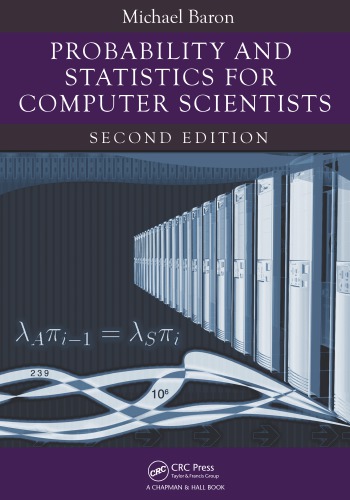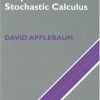Probability and statistics for computer scientists 2nd Edition by Michael Baron 1482214105 9781482214109
$50.00 Original price was: $50.00.$35.00Current price is: $35.00.
Probability and statistics for computer scientists 2nd Edition by Michael Baron – Ebook PDF Instant Download/Delivery: 1482214105, 9781482214109
Full download Probability and statistics for computer scientists 2nd Edition after payment

Product details:
ISBN 10: 1482214105
ISBN 13: 9781482214109
Author: Michael Baron
Incorporating feedback from instructors and researchers who used the previous edition, Probability and Statistics for Computer Scientists, Second Edition helps students understand general methods of stochastic modeling, simulation, and data analysis; make optimal decisions under uncertainty; model and evaluate computer systems and networks; and prepare for advanced probability-based courses. Written in a lively style with simple language, this classroom-tested book can now be used in both one- and two-semester courses.
New to the Second Edition
- Axiomatic introduction of probability
- Expanded coverage of statistical inference, including standard errors of estimates and their estimation, inference about variances, chi-square tests for independence and goodness of fit, nonparametric statistics, and bootstrap
- More exercises at the end of each chapter
- Additional MATLAB® codes, particularly new commands of the Statistics Toolbox
In-Depth yet Accessible Treatment of Computer Science-Related Topics
Starting with the fundamentals of probability, the text takes students through topics heavily featured in modern computer science, computer engineering, software engineering, and associated fields, such as computer simulations, Monte Carlo methods, stochastic processes, Markov chains, queuing theory, statistical inference, and regression. It also meets the requirements of the Accreditation Board for Engineering and Technology (ABET).
Encourages Practical Implementation of Skills
Using simple MATLAB commands (easily translatable to other computer languages), the book provides short programs for implementing the methods of probability and statistics as well as for visualizing randomness, the behavior of random variables and stochastic processes, convergence results, and Monte Carlo simulations. Preliminary knowledge of MATLAB is not required. Along with numerous computer science applications and worked examples, the text presents interesting facts and paradoxical statements. Each chapter concludes with a short summary and many exercises.
Table of contents:
Chapter 1 Introduction and Overview
1.1 Making decisions under uncertainty
Summary and conclusion
1.2 Overview of this book
Summary and conclusions
Exercises
Figure 1.1
Part I Probability and Random Variables
Chapter 2 Probability
2.1 Events and their probabilities
2.1.1 Outcomes, events, and the sample space
2.1.2 Set operations
2.2 Rules of Probability
2.2.1 Axioms of Probability
2.2.2 Computing probabilities of events
Extreme cases
Union
Complement
Intersection of independent events
2.2.3 Applications in reliability
2.3 Combinatorics
2.3.1 Equally likely outcomes
2.3.2 Permutations and combinations
Permutations with replacement
Permutations without replacement
Combinations without replacement
Computational shortcuts
Combinations with replacement
2.4 Conditional probability and independence
Conditional probability
Independence
Bayes Rule
Law of Total Probability
Summary and conclusions
Exercises
Figure 2.1
Figure 2.2
Figure 2.3
Figure 2.4
Figure 2.5
Figure 2.6
Figure 2.7
Figure 2.8
Chapter 3 Discrete Random Variables and Their Distributions
3.1 Distribution of a random variable
3.1.1 Main concepts
3.1.2 Types of random variables
3.2 Distribution of a random vector
3.2.1 Joint distribution and marginal distributions
3.2.2 Independence of random variables
3.3 Expectation and variance
3.3.1 Expectation
3.3.2 Expectation of a function
3.3.3 Properties
3.3.4 Variance and standard deviation
3.3.5 Covariance and correlation
3.3.6 Properties
3.3.7 Chebyshev’s inequality
3.3.8 Application to finance
3.4 Families of discrete distributions
3.4.1 Bernoulli distribution
3.4.2 Binomial distribution
MATLAB notes
3.4.3 Geometric distribution
3.4.4 Negative Binomial distribution
3.4.5 Poisson distribution
3.4.6 Poisson approximation of Binomial distribution
Summary and conclusions
Exercises
Figure 3.1
Figure 3.2
Figure 3.3
Figure 3.4
Figure 3.5
Figure 3.6
Chapter 4 Continuous Distributions
4.1 Probability density
Analogy: pmf versus pdf
Joint and marginal densities
Expectation and variance
4.2 Families of continuous distributions
4.2.1 Uniform distribution
The Uniform property
Standard Uniform distribution
Expectation and variance
4.2.2 Exponential distribution
Times between rare events are Exponential
Memoryless property
4.2.3 Gamma distribution
Expectation, variance, and some useful integration remarks
Gamma-Poisson formula
4.2.4 Normal distribution
Standard Normal distribution
4.3 Central Limit Theorem
Normal approximation to Binomial distribution
Continuity correction
Summary and conclusions
Exercises
Figure 4.1
Figure 4.2
Figure 4.3
Figure 4.4
Figure 4.5
Figure 4.6
Table 4.1
Table 4.2
Table 4.3
Chapter 5 Computer Simulations and Monte Carlo Methods
5.1 Introduction
5.1.1 Applications and examples
5.2 Simulation of random variables
5.2.1 Random number generators
5.2.2 Discrete methods
Arbitrary discrete distribution
5.2.3 Inverse transform method
Arbitrary continuous distribution
Discrete distributions revisited
Exponential-Geometric relation
5.2.4 Rejection method
5.2.5 Generation of random vectors
5.2.6 Special methods
Poisson distribution
Normal distribution
5.3 Solving problems by Monte Carlo methods
5.3.1 Estimating probabilities
Accuracy of a Monte Carlo study
5.3.2 Estimating means and standard deviations
5.3.3 Forecasting
5.3.4 Estimating lengths, areas, and volumes
Lengths
Areas and volumes
Areas of arbitrary regions with unknown boundaries
5.3.5 Monte Carlo integration
Accuracy of results
Improved Monte Carlo integration method
Accuracy of the improved method
Summary and conclusions
Exercises
Figure 5.1
Figure 5.2
Figure 5.3
Figure 5.4
Figure 5.5
Figure 5.6
Figure 5.7
Figure 5.8
Part II Stochastic Processes
Chapter 6 Stochastic Processes
6.1 Definitions and classifications
6.2 Markov processes and Markov chains
6.2.1 Markov chains
Characteristics of a Markov chain
6.2.2 Matrix approach
6.2.3 Steady-state distribution
Computing the steady-state distribution
The limit of Ph
Steady state
Existence of a steady-state distribution. Regular Markov chains
Conclusion
6.3 Counting processes
6.3.1 Binomial process
Relation to real time: frames
Markov property
6.3.2 Poisson process
Continuous time
Poisson process as the limiting case
Rare events and modeling
6.4 Simulation of stochastic processes
Discrete-time processes
Markov chains
Binomial process
Continuous-time processes
Poisson process
Summary and conclusions
Exercises
Figure 6.1
Figure 6.2
Figure 6.3
Figure 6.4
Figure 6.5
Figure 6.6
Figure 6.7
Figure 6.8
Figure 6.9
Figure 6.10
Chapter 7 Queuing Systems
7.1 Main components of a queuing system
Arrival
Queuing and routing to servers
Service
Departure
7.2 The Little’s Law
7.3 Bernoulli single-server queuing process
Markov property
Steady-state distribution
7.3.1 Systems with limited capacity
7.4 M/M/1 system
M/M/1 as a limiting case of a Bernoulli queuing process
Steady-state distribution for an M/M/1 system
7.4.1 Evaluating the system’s performance
Utilization
Waiting time
Response time
Queue
Little’s Law revisited
When a system gets nearly overloaded
7.5 Multiserver queuing systems
7.5.1 Bernoulli k-server queuing process
Markov property
Transition probabilities
7.5.2 M/M/k systems
Steady-state distribution
7.5.3 Unlimited number of servers and M/M/∞
M/M/∞ queueing system
7.6 Simulation of queuing systems
Markov case
General case
Example: simulation of a multiserver queuing system
Summary and conclusions
Exercises
Figure 7.1
Figure 7.2
Figure 7.3
Figure 7.4
Figure 7.5
Part III Statistics
Chapter 8 Introduction to Statistics
8.1 Population and sample, parameters and statistics
Sampling and non-sampling errors
8.2 Simple descriptive statistics
8.2.1 Mean
Unbiasedness
Consistency
Asymptotic Normality
8.2.2 Median
Understanding the shape of a distribution
Computation of a population median
Computing sample medians
8.2.3 Quantiles, percentiles, and quartiles
8.2.4 Variance and standard deviation
Computation
8.2.5 Standard errors of estimates
8.2.6 Interquartile range
Detection of outliers
Handling of outliers
8.3 Graphical statistics
8.3.1 Histogram
How else may histograms look like?
Mixtures
The choice of bins
8.3.2 Stem-and-leaf plot
8.3.3 Boxplot
Parallel boxplots
8.3.4 Scatter plots and time plots
MATLAB notes
Summary and conclusions
Exercises
Figure 8.1
Figure 8.2
Figure 8.3
Figure 8.4
Figure 8.5
Figure 8.6
Figure 8.7
Figure 8.8
Figure 8.9
Figure 8.10
Figure 8.11
Figure 8.12
Chapter 9 Statistical Inference I
9.1 Parameter estimation
9.1.1 Method of moments
Moments
Estimation
9.1.2 Method of maximum likelihood
Discrete case
Continuous case
9.1.3 Estimation of standard errors
9.2 Confidence intervals
9.2.1 Construction of confidence intervals: a general method
9.2.2 Confidence interval for the population mean
9.2.3 Confidence interval for the difference between two means
9.2.4 Selection of a sample size
9.2.5 Estimating means with a given precision
9.3 Unknown standard deviation
9.3.1 Large samples
9.3.2 Confidence intervals for proportions
9.3.3 Estimating proportions with a given precision
9.3.4 Small samples: Student’s t distribution
9.3.5 Comparison of two populations with unknown variances
Case 1. Equal variances
9.4 Hypothesis testing
9.4.1 Hypothesis and alternative
9.4.2 Type I and Type II errors: level of significance
9.4.3 Level α tests: general approach
Step 1. Test statistic
Step 2. Acceptance region and rejection region
Step 3: Result and its interpretation
9.4.4 Rejection regions and power
9.4.5 Standard Normal null distribution (Z-test)
9.4.6 Z-tests for means and proportions
9.4.7 Pooled sample proportion
9.4.8 Unknown σ: T-tests
9.4.9 Duality: two-sided tests and two-sided confidence intervals
9.4.10 P-value
How do we choose α?
P-value
Testing hypotheses with a P-value
Computing P-values
Understanding P-values
9.5 Inference about variances
9.5.1 Variance estimator and Chi-square distribution
9.5.2 Confidence interval for the population variance
9.5.3 Testing variance
Level α test
P-value
9.5.4 Comparison of two variances. F-distribution.
9.5.5 Confidence interval for the ratio of population variances
9.5.6 F-tests comparing two variances
MATLAB notes
Summary and conclusions
Exercises
Figure 9.1
Figure 9.2
Figure 9.3
Figure 9.4
Figure 9.5
Figure 9.6
Figure 9.7
Figure 9.8
Figure 9.9
Figure 9.10
Figure 9.11
Figure 9.12
Figure 9.13
Figure 9.14
Figure 9.15
Table 9.1
Table 9.2
Table 9.3
Table 9.4
Table 9.5
Table 9.6
Chapter 10 Statistical Inference II
10.1 Chi-square tests
10.1.1 Testing a distribution
10.1.2 Testing a family of distributions
10.1.3 Testing independence
10.2 Nonparametric statistics
10.2.1 Sign test
10.2.2 Wilcoxon signed rank test
Null distribution of Wilcoxon test statistic
Exact distribution
Normal approximation
10.2.3 Mann-Whitney-Wilcoxon rank sum test
Mann-Whitney-Wilcoxon test in MATLAB
Null distribution of Mann-Whitney-Wilcoxon test statistic
Normal approximation
10.3 Bootstrap
10.3.1 Bootstrap distribution and all bootstrap samples
Bootstrap distribution
10.3.2 Computer generated bootstrap samples
10.3.3 Bootstrap confidence intervals
Parametric method, based on the bootstrap estimation of the standard error
Nonparametric method, based on the bootstrap quantiles
10.4 Bayesian inference
10.4.1 Prior and posterior
Conjugate distribution families
Gamma family is conjugate to the Poisson model
Beta family is conjugate to the Binomial model
Normal family is conjugate to the Normal model
10.4.2 Bayesian estimation
10.4.3 Bayesian credible sets
10.4.4 Bayesian hypothesis testing
Loss and risk
Summary and conclusions
Exercises
Figure 10.1
Figure 10.2
Figure 10.3
Figure 10.4
Figure 10.5
Figure 10.6
Figure 10.7
Figure 10.8
Figure 10.9
Figure 10.10
Figure 10.11
Figure 10.12
Figure 10.13
Figure 10.14
Table 10.1
Table 10.2
Chapter 11 Regression
11.1 Least squares estimation
11.1.1 Examples
11.1.2 Method of least squares
11.1.3 Linear regression
Estimation in linear regression
11.1.4 Regression and correlation
11.1.5 Overfitting a model
11.2 Analysis of variance, prediction, and further inference
11.2.1 ANOVA and R-square
11.2.2 Tests and confidence intervals
Degrees of freedom and variance estimation
Inference about the regression slope
ANOVA F-test
F-test and T-test
11.2.3 Prediction
Confidence interval for the mean of responses
Prediction interval for the individual response
Prediction bands
11.3 Multivariate regression
11.3.1 Introduction and examples
11.3.2 Matrix approach and least squares estimation
Matrix approach to multivariate linear regression
Least squares estimates
11.3.3 Analysis of variance, tests, and prediction
Testing significance of the entire model
Variance estimator
Testing individual slopes
Prediction
11.4 Model building
11.4.1 Adjusted R-square
11.4.2 Extra sum of squares, partial F-tests, and variable selection
Stepwise (forward) selection
Backward elimination
11.4.3 Categorical predictors and dummy variables
Avoid singularity by creating only (C − 1) dummies
Interpretation of slopes for dummy variables
Matlab notes
Summary and conclusions
Exercises
Figure 11.1
Figure 11.2
Figure 11.3
Figure 11.4
Figure 11.5
Figure 11.6
Table 11.1
Part IV Appendix
Chapter 12 Appendix
12.1 Inventory of distributions
12.1.1 Discrete families
12.1.2 Continuous families
12.2 Distribution tables
12.3 Calculus review
12.3.1 Inverse function
12.3.2 Limits and continuity
12.3.3 Sequences and series
12.3.4 Derivatives, minimum, and maximum
Computing maxima and minima
12.3.5 Integrals
Improper integrals
Integration by substitution
Integration by parts
Computing areas
Gamma function and factorial
12.4 Matrices and linear systems
Multiplying a row by a column
Multiplying matrices
Transposition
Solving systems of equations
Inverse matrix
Matrix operations in Matlab
12.5 Answers to selected exercises
People also search:
where to learn probability and statistics
probability and statistics for computer scientists solutions
how statistics and probability are related
applications of probability and statistics in computer science
statistic and probability formula
Tags: Michael Baron, Probability, statistics, computer



